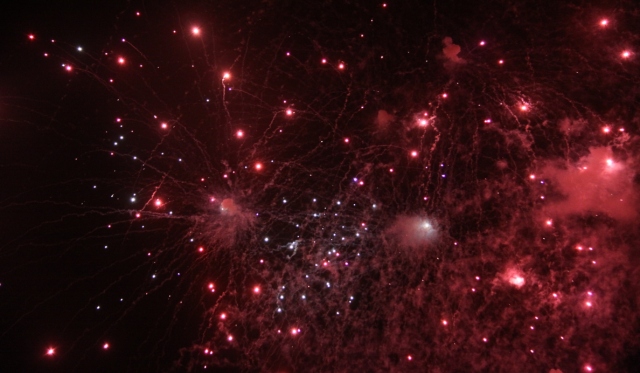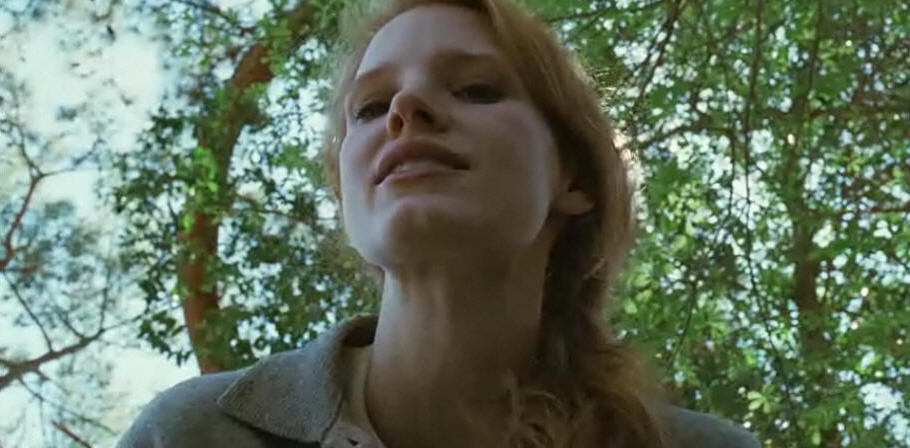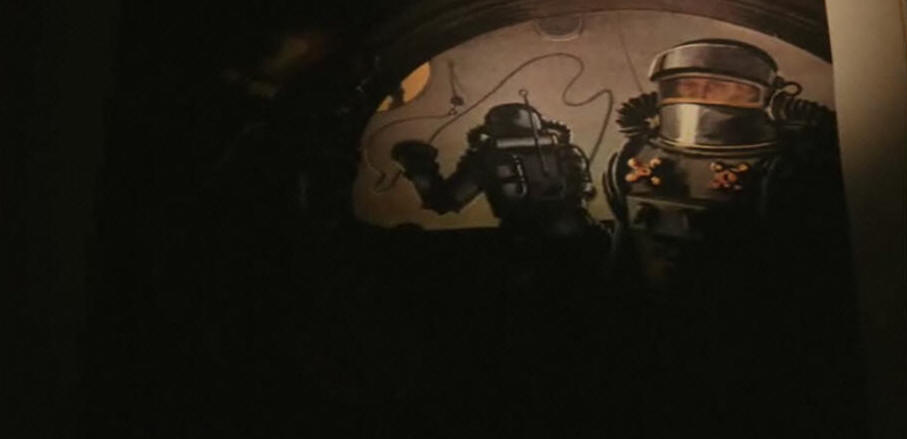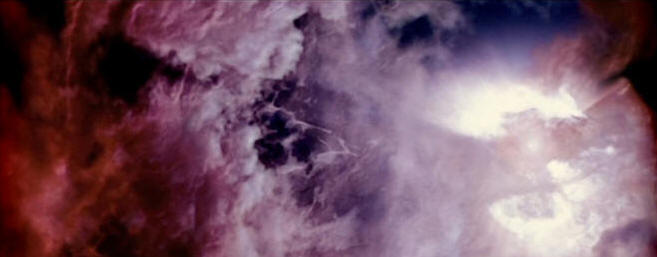MOVIE REVIEWS |
INTERVIEWS |
YOUTUBE |
NEWS
|
EDITORIALS | EVENTS |
AUDIO |
ESSAYS |
ARCHIVES |
CONTACT
|
PHOTOS |
COMING SOON|
EXAMINER.COM FILM ARTICLES
||HOME

Thursday, July 14, 2011
ESSAY
"The
Tree Of Life": A Multi-Part Exploration: Part Three

Omar P.L. Moore
by
Omar P.L. Moore/PopcornReel.com
 FOLLOW
FOLLOW
Thursday,
July 14, 2011
SPOILER ALERT: If you haven't seen "The Tree Of Life" but plan to, it is probably not a good
idea to read any further.
PART THREE Cover
| Intro
| Part One
| Two
The HEADSPACE of older Jack, Sean Penn's existence, and a bridge to the
past

Jessica Chastain as Mrs. O'Brien in "The Tree Of Life". "You'll be grown
before that tree is tall."
Fox Searchlight
It's fairly easy to see that the entire film takes place in the head of the
older Jack (Sean Penn). Jack is in his fifties now, an architect somewhere
in Texas, and for an entire day at work he has been distracted. Perhaps
this day in particular has been distracting because it may be the anniversary of
the death of his younger brother R.L. A 25th or 30th anniversary,
possibly.
In any event, for the duration of "The Tree Of Life" Mr. Penn's
older Jack is probably
situated in 2011 (or more accurately, 2008, the year in which Mr. Malick's
sci-fi drama was filmed) thinking throughout his work day about R.L., his
untimely loss and the guilt Jack has carried because of it. In one of the
three pieces of dialogue that Mr. Penn has -- the only person-to-person dialogue
older Jack has is, "what are you gonna do?", a line he says to a fellow work colleague
while focused on work and other things -- he apologizes during a cell phone
conversation with his dad while in an elevator. The conversation is
presumably centered around R.L., and Jack is apologizing to his father, whom he
calls "dad". Later in the film we see that Mr. O'Brien has forbidden the
younger Jack from calling him "dad", only wanting himself to be addressed as
"father".
"The Tree Of Life" isn't a flashback. It's a thought-forward and a
thought-backward. A memory log, a collage, punctuated by the earth's
reverberations, elements of nature perhaps even interacting with Jack's
memories. Water, fire, and trees are amplified in these shots during the
film's phenomenal 18-minute and 9-minute image sequences, juxtaposed with micro
editions of these same elements in the scenes involving the O'Briens.
These entities are always interacting with each other.
Jack, encased in the glass structure of his office in Texas, has been thinking
about the glass house of his youth. In his mind he has been walking around in
it. Around and around. In each scene -- virtually every single scene
-- there are trees, glass and water. This cinematic representation of
Jack's mind -- his memory, his thoughts, his recollections, are shot and edited
together seamlessly. There's a constant in mood, feel, pace and delivery
to each of these memories. The music that swells is classical, over the
soundtrack for the moviegoer, as well as the music Mr. O'Brien plays in the film on
vinyl records. The louder music we hear might represent the vitality and strength
of Jack's most vivid memories and recollections.
At one point in the office building early on, Jack says on the phone, "I'm feel
like I'm just bumping into walls here." The walls of his own mind trapped
in the memories of the past? Of that glass house and those trees that Mr.
Malick shoots so lovingly?
Jack is now married. He walks around an airy and distinctly-shaped glass
house, all its windows, the stairs, so neatly designed by Jack Fisk. The
house offers a wealth of light, space and a view of trees, yet feels a
little claustrophobic. Jack is still rooted in the 1950s, a past he has
never forgiven himself for. He walks around his present-day house in a
trance. Jack doesn't speak to his wife, a woman who looks a little younger
than he. Jack's wife bears a very distant resemblance to the young girl in
the 1950s that Jack likes, as well as a fleeting resemblance to the woman he
stole the night slip from all those years ago. Jack and his wife don't
have any children, at least as far as we can see or discern. Is Jack
afraid to? Did they ever have children? Did they lose a child?
How long have they been married?
In his films Mr. Malick shows off wedding bands wonderfully well. They
gleam with pride, pristine, even powerful. I recall a similar shot in "The
New World": a 3/4 close-up shot of a man's hand with a ring on it early on in
that film, and in "The Tree Of Life" on at least three occasions we see the
wedding band of a married O'Brien, one of the shots displayed at the moment Jack
touches Mrs. O'Brien's pregnant belly. There's a tradition, a security and
a safety represented by the shot just described, and it's a beautiful
juxtaposition, one of the film's many great compositions.
Memories are never far away from any of us, and Jack's memories are potent, and
wonderfully constructed by Mr. Fisk and shot by Mr. Lubezki. There isn't
the haziness and soupy white that many thought-processed visions on film are
usually depicted or steeped in, just artifacts of the past (trees, grass,
leaves, glass) that appear and reappear throughout the film, fragments of Jack's
earlier life.

I've no clue which book this is from, but is this an homage of sorts to Stanley
Kubrick's "2001: A Space Odyssey"?
Fox Searchlight
Throughout "The Tree Of Life" the elements of the universe bump up
against the
human lives who exist within those elements, until finally the two merge in the
beach sequence that finishes the film. It's still, after multiple viewings
the most troubling -- the only troubling sequence of the film, and its weakest
sequence. Yet it illustrates an imagined, if not real reconciliation
between and amongst the fortunate, the despised, the lost, the reviled, the
celebrated, the loved. (Had all of the participants and the dinosaurs and
the frogs and the rest of the creatures from "The Lion King" and Noah's Ark
bowed and smiled into the camera like the cast of "Titanic" during this sequence
I'd have lost all credibility in the ardor and sincerity of Mr. Malick's film.)
There's a look that Mr. O'Brien gives older Jack that seems to communicate
forgiveness, that he forgives Jack. As acted by Mr. Pitt, who merits
award consideration for his work, it's a moment that encapsulates a resolution
between them, as imagined by Jack.
The beach sequence, interspersed by the spiritual and metaphysical "delivery" of
R.L. from Mrs. O'Brien's womb into God's hands ("He was in God's hands all the
time") -- represents a resolution and assuaging of Jack's guilt and outsider status from the
O'Brien family, and the resolution of older Jack's thoughts, if not the resolution of
the film*. There's an ephemeral smile on Jack's face as he stands outside
the towering glass building as he looks off camera, a flicker of contentedness
at having journeyed through the exploration of his own mind of his prayers to
God and his reconnection to his family. Moments earlier as Jack has
stepped out into the present-day real world of 2008 it looks as if he is briefly
jarred into reality.
*Has there really been a resolution in the film? Since "The Tree Of Life"
doesn't have a narrative the film isn't really "resolved" so much as it is
stopped. And that bridge, that big bridge, represents the metaphysical
gulf of thought and memory that Jack has had to travel across and mine during the
course of the film. That bridge represents a connection and a reconnection
to Jack's 1950s family -- Mr. O'Brien, Mrs. O'Brien, R.L. and his youngest
brother -- a family whom older Jack has presumably been distant from emotionally and
physically in the years since R.L.'s death.

A shot from "The Tree Of Life", directed by Terrence Malick.
Fox Searchlight
Earlier in the film we see three large, separated pipes towering into the sky,
at the plant where Mr. O'Brien works. Is the bridge we see at the end of
the film a representation of a different kind of physical connection to the
plant? Jack's own answer or his imagined equivalent to that connection?
Is it a construction built perhaps by the company Mr. O'Brien worked at?
Jack is an architect, and by definition he's a builder. Did Jack's
employer company build it before Jack got there as an employee? One
thing's for sure, Jack's occupation as an architect is a perfectly appropriate
profession for the scale and detail of "The Tree Of Life". Older
Jack has building and constructing his memories of his younger life throughout
the film, just like an architect.
For me, the Sean Penn sequences work for the film. They are vital,
indispensible to it. I believe they give the film the shape and dimension
that solidifies it. "The Tree Of Life" isn't merely a bundle of images but
are images experienced, relived and re-thought by someone, namely Jack.
Having Mr. Penn as the older character processing, remembering and recollecting
these thoughts and details lends depth to the film and shows us a man dedicated
to searching, understanding and feeling. Mr. Malick gives Mr. Penn to us
as the film's touchstone, the man we as an audience take this journey with.
Would the film have been better without Mr. Penn's older Jack character? I'm not
sure. But I believe "The Tree Of Life" thrives and is more meaningful with
his character in it.
Similarly, "2001: A Space Odyssey" (1968) was
propelled by the experiences of Keir Dullea's character Bowman -- albeit
integral to that film since he was a defined protagonist in, whereas in "The
Tree Of Life" Mr. Penn's Jack isn't a protagonist at all. Bowman's experiences in the final stages of
Stanley Kubrick's classic epic are more structured, while Jack's are fragmented
yet just as alive and vivid. Interestingly, much of "2001"
isn't seen through the eyes of a character. Mr. Kubrick's explorations are
shown as explorations, while Mr. Malick's explorations are impressionistic and abstract. Both
films are marvelous.
THE END
Cover
| Intro
| Part One
| Two
COPYRIGHT 2011. POPCORNREEL.COM. ALL RIGHTS RESERVED.  FOLLOW
FOLLOW
SUBSCRIBE TO THE POPCORN REEL MOVIE
REVIEWS RSS FEED

MOVIE REVIEWS |
INTERVIEWS |
YOUTUBE |
NEWS
|
EDITORIALS | EVENTS |
AUDIO |
ESSAYS |
ARCHIVES |
CONTACT
| PHOTOS |
COMING SOON|
EXAMINER.COM FILM ARTICLES
||HOME

 FOLLOW
FOLLOW


 FOLLOW
FOLLOW